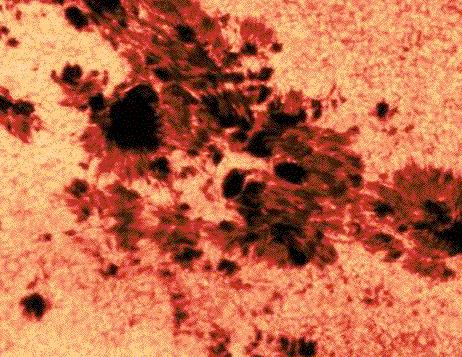
|
Credit & Copyright: National Solar Observatory
Explanation:
Our Sun has spots!
These spots appear dark in photographs like the one above, but
in fact sunspots are quite bright - they are just dark compared
to the rest of the Sun. Sunspots are about the size of the
Earth and
frequently occur in groups, as shown above. Sunspots occur when a concentrated portion of the
Solar magnetic field pokes through the surface.
This field slows energy from entering the sunspot region, causing sunspots to appear cooler,
darker, and lower than the surrounding surface.
Sunspots typically last a
few days before dissipating. The number of sunspots
is always changing, generally going from a
maximum to a minimum about every 5 ½ years.
In fact, the Sun just passed a minimum two years ago.
The Sun and sunspots should never be looked at directly.
|
January February March April May June July August September October November December |
| |||||||||||||||||||||||||||||||||||||||||||||||||||||||
NASA Web Site Statements, Warnings, and Disclaimers
NASA Official: Jay Norris. Specific rights apply.
A service of: LHEA at NASA / GSFC
& Michigan Tech. U.
Based on Astronomy Picture
Of the Day
Publications with keywords: Sun - sunspot
Publications with words: Sun - sunspot
See also:
- APOD: 2025 December 7 Á The Sun and Its Missing Colors
- APOD: 2025 May 21 Á International Space Station Crosses the Sun
- APOD: 2025 March 16 Á Venus and the Triply Ultraviolet Sun
- APOD: 2024 September 2 Á A Triangular Prominence Hovers Over the Sun
- APOD: 2024 August 18 Á A Solar Prominence Eruption from SDO
- APOD: 2024 August 4 Á Gaia: Here Comes the Sun
- APOD: 2024 July 28 Á Sun Dance
